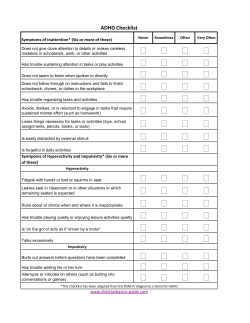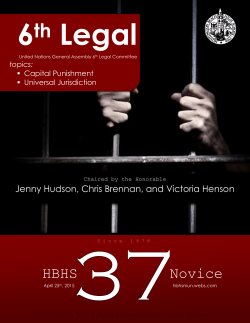
February, 2014 Managing ADHD Behavior in the Classroom
“WE CAN’T DIRECT THE WIND… BUT WE CAN ADJUST THE SAILS” Managing ADHD Behavior in the Classroom Richard D. Lavoie, M.A., M.Ed. Visiting Lecturer – Harvard University BELOIT MINDSET LIST • • • • • • • • The internet Union disputes TV dials LBJ Arnold Palmer USSR Woolworth’s MLB Wild Card Justice Ruth Ginsberg Michael Landon State abbreviations Cursive Leno/Letterman Czechoslovakia Ferris Bueller “Our understanding and knowledge of the CAUSES of behavior will dictate our responses to that behavior.” Ross Greene ADHD is not just the “Big Three” anymore…. • Inattention • Hyperactivity • Impulsivity INTENSITY (SEVERITY) EXTENSITY (IMPACT) STIGMATA (OUTWARD APPEARANCE) SLEEP ABNORMALITIES • • • • Failure to achieve consistent REM stages Difficulty falling asleep Difficulty awakening Results in tardiness, irritability, sleep deprivation symptoms, morning battles DEVELOPMENT/MATURITY DELAYS “Immaturity”, ” Irresponsible”, “Acts younger than his CA…” CA BA 6 9 12 15 18 21 24 27 3 6 9 12 15 18 21 24 CO-MORBIDITY (Coexisting Conditions) • ESTIMATED 66% OF ADHD STUDENTS HAVE CONCOMMITENT CONDITIONS……… • • • • • • Anxiety………………………34% Depression……………….…16% Substance abuse………...….5% OCC/ODD……………….….40% Learning disorders……...….50% Conduct disorders………....15% CD versus ODD • Conduct disorder (Aggressive, intimidates, fights, cruelty, destructive, steals, very deceitful, serious violations.) • Oppositional Defiant Disorder (temper, argumentative, non compliant, blames others, easily annoyed and distracted, angry, vindictive, “bears a grudge”) LOW FRUSTRATION TOLERANCE • Difficulty controlling/monitoring/ identifying emotions • Emotionally reactive, “short fuse” • Lack of perseverance, gives up easily • Greatly concerned with OWN feelings, insensitive to feelings of others. • Appears selfish, self-absorbed FAILS TO LEARN FROM EXPERIENCE • Repeats misbehavior, despite interventions • Difficult to manage and discipline • Unlikely to adhere to rules. • Not reflective, little hindsight • Requires immediate feedback, longterm rewards of minimal value, effectiveness. • Difficulty examining, analyzing or modifying his own behavior TEMPORAL CONCEPTS • Inability to appreciate order and recurring patterns • Loses track of time • Often late • Marked difficulty estimating the time required for tasks • Impatient • Hates waiting • “Time creeps” IMPAIRED EXECUTIVE FUNCTIONING • Active working memory • Impulsivity • Controlling emotions • Difficulty directing behavior goals • Problem solving KINETIC MELODIES • Stored patterns of familiar motor actions • Difficulty performing repetitive, familiar motor patterns despite repeated exposures. PERFORMANCE INCONSISTENCY • Work quality varies hour to hour • Baffling behavior that leads to misdiagnosis that “motivation” is the problem • Creates feelings of guilt, helplessness, anxiety THEREFORE………. • TRADITIONAL MANAGEMENT STRATEGIES SIMPLY DO NOT WORK !!! • Threats • Rewards • Punishment • Comparisons • Behavior Charts • Demerits • Behavior Modification OTHER STRATEGIES THAT DON’T WORK • • • • • • Isolation Corporal Punishment Forced apologies Sarcasm Cheap shots Collective punishment UNIVERSAL DESIGN • • • • • • Automatic door openers Elevators Curb cuts Door handles Closed captioning Also, electric toothbrushes, fire alarms, flexstraws, etc. BUMPERSTICKERS and PARADIGM SHIFTS “If you don’t stand for SOMETHING, you’ll fall for almost ANYTHING !!” “CHALLENGING BEHAVIOR IS NOT A PROBLEM…..IT’S A SYMPTOM.” “Hurt people hurt people.” “The pain that a troubled child CAUSES is never greater than the pain that he feels.” “Kids with ADHD have the regrettable ability to elicit from adults the exact opposite emotional reaction than the child needs at the time.” “Adolescence is a 24 hour-aday, 365 day-a-year battle to NOT BE EMBARRASSED !!” Dr. Mel Levine “Punishment is not designed to ‘pay’ for past infractions….it’s designed to prevent future ones.” “At any given moment, any kid would rather be viewed as a BAD kid than a DUMB kid.” “Behavior that is reinforced is replicated” “POSITIVE feedback changes behavior… NEGATIVE feedback only STOPS behavior.” SUCCESSIVE APPROXIMATIONS: Reinforce direction, not perfection. “If you wouldn’t do it to an adult….don’t do it to a kid.” “A well-managed class is one where every student is SAFE and SUCCESSFUL.” ABANDONING ASSUMPTIONS • That others will listen to you and take an interest in your communication. • That others will be consistent in their behaviors and reactions. • That others will be realistic and rational. • That others will understand and accept your reality. …a word about POWER !!!! PREVENTIVE DISCIPLINE • Proactive strategies • Situational Analysis • Corrective strategies STRATEGY #1 Structure and routine STRATEGY #2 Worst case scenario STRATEGY #3 Establish and maintaining rules EFFECTIVE CLASSROOM RULES • • • • • Post ‘em CONSULT with kids State what you WANT Measurable and observable Add, modify, eliminate rules as the year progresses • Use rules that generalize • Number the rules…..>7,8 • Refer to rules when broken…or followed ! STRATEGY #4 • Plan for and prepare for transitions. • Beginning • Middle • End STRATEGY #5 Earn a chance to take a chance STRATEGY #6 Getting a commitment STRATEGY #7 Minor choice technique STRATEGY #8 Establishing an Anticipatory Set STRATEGY #9 Setting an agenda TUESDAY • Collect, correct homework • Finish discussion of Presidential Succession • Mapwork activity • Rules for National Essay Contest • Michael’s presentation on MLK • Distribute, explain homework • Finish DVD of JFK Assassination STRATEGY #10 Using effective questioning strategies • • • • Avoid handraising…depend on eye contact Wait 3 seconds Find a germ of accuracy in responses Recall-to-recognition… convert to multiple choice • Directed questioning • Fair warning • DON’T SAY, “Are there any questions?” STRATEGY # 11 Define spaces in the classroom STRATEGY #12 Use “Teachable Moments” SITUATIONAL ANALYSIS CORRECTIVE DISCIPLINE WHY PUNISHMENT SELDOM WORKS • • • • • • • • Been punished enough !! Does not eliminate…just represses behavior Doesn’t model desired behavior Models aggression and use/abuse of power “Message” gets lost in fear, anger, anxiety Associates punishment with the punisher Doesn’t transfer of generalize Only effective as long as threat of punishment exists FOUR R’s OF PUNISHMENT • Related • Respect • Reasonable • REVEALED “EFFECTIVE PUNISHMENT IS IMMEDIATE and/or DEFINITE” CD STRATEGY #1 • Please……..ten • Need……….ten • Need…….. Now !!!! CD STRATEGY #2 • WHISPERING • To acknowledge positive responses • As intervention….don’t wait for a response • Proximity control CD STRATEGY #3 • Broken Record Technique • Why argue? • Voice, body language, repeat RULE CD STRATEGY #4 “Make an appointment…..” CD STRATEGY #5 “Focused Corrections” CD STRATEGY #6 MILLIMETER AT A TIME • Millimeter concession • Millimeter admission • Millimeter recognition CD STRATEGY #7 Respect the struggle CD STRATEGY #8 Use administrative intervention wisely CD STRATEGY #9 “Express quality and expectation” CD STRATEGY #10 DIFFERENTIAL ATTENTION Break eye contact Encourage another Praise positive interaction BEWARE of extinction burst CD STRATEGY #11 Direct Appeal CD STRATEGY #12 Worst choice option A Good Coach……. • • • • • • • • • • Wants all players to do well and win Knows each player Defines group and individual goals Uses strengths Works on weaknesses Knows opponent Considers conditions Instructs at proper level Applies new skills, reviews old skills Constantly evaluating an re-teaching The HIDDEN CURRICULUM “Each school…each family…each classroom has its own individual and unique culture” IDENTIFYING THE HIDDEN CURRICULUM IN YOUR SCHOOL RESOURCES: •Colleagues •Students •Student Council •Support Staff (nurse, librarian, custodians) TECHNIQUES • Interviews (staff, students, parents, alumni) • Surveys • Brainstorming • InHouse publications (Yearbooks, student newspaper, etc.) • Observation CONSIDERATIONS • PHYSICAL PLANT SOCIAL ENVIRONMENT ADMINISTRATION TEACHING STAFF EXTRACURRICULAR OPTIONS SCHEDULE OUTSIDE THE SCHOOL rick@ricklavoie.com
© Copyright 2025




















